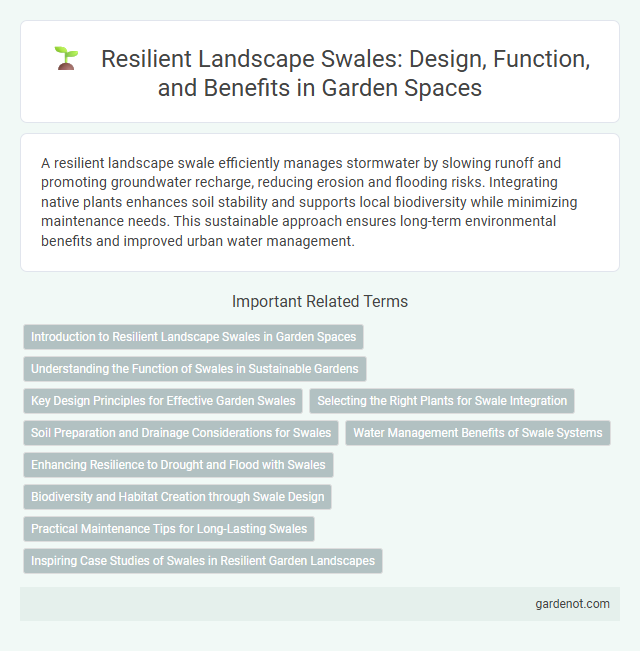A resilient landscape swale efficiently manages stormwater by slowing runoff and promoting groundwater recharge, reducing erosion and flooding risks. Integrating native plants enhances soil stability and supports local biodiversity while minimizing maintenance needs. This sustainable approach ensures long-term environmental benefits and improved urban water management.
Introduction to Resilient Landscape Swales in Garden Spaces
Resilient landscape swales are designed to efficiently manage stormwater by capturing and slowly infiltrating runoff, reducing erosion and promoting groundwater recharge. These shallow, vegetated channels support diverse plant life that stabilizes soil while enhancing urban garden spaces with natural aesthetics. Incorporating swales in garden designs improves water conservation and fosters a sustainable, climate-adaptive landscape.
Understanding the Function of Swales in Sustainable Gardens
Resilient landscape swales play a crucial role in sustainable garden design by efficiently managing stormwater runoff, reducing soil erosion, and promoting groundwater recharge. These shallow, vegetated channels are strategically placed to capture and slow rainwater, allowing it to infiltrate the soil and nourish plant roots while preventing flooding. Incorporating swales into garden landscapes supports biodiversity, enhances soil health, and creates a self-sustaining water management system aligned with ecological principles.
Key Design Principles for Effective Garden Swales
Resilient landscape swales rely on precise grading, soil permeability, and native vegetation to efficiently capture and infiltrate stormwater while minimizing erosion. Key design principles include creating gentle side slopes of 3:1 or flatter for stability, incorporating a stable outlet to prevent overflow damage, and selecting deep-rooted plants that enhance soil structure and water absorption. Properly designed garden swales promote groundwater recharge, reduce surface runoff, and support biodiversity within urban and rural landscapes.
Selecting the Right Plants for Swale Integration
Selecting drought-tolerant, deep-rooted native plants enhances the resilience of landscape swales by improving soil stability and water infiltration. Species such as switchgrass, sedges, and wildflowers like coneflowers not only thrive in fluctuating moisture conditions but also support local biodiversity. Proper plant selection reduces erosion, filters pollutants, and ensures long-term swale functionality under varying weather patterns.
Soil Preparation and Drainage Considerations for Swales
Resilient landscape swales require well-prepared soil with appropriate organic matter content and proper grading to ensure effective water infiltration and prevent erosion. Soil compaction must be minimized through deep tilling and incorporation of compost to enhance permeability and root penetration. Proper drainage considerations include designing swales with gentle side slopes and outlet structures to manage stormwater runoff efficiently and reduce flood risks.
Water Management Benefits of Swale Systems
Resilient landscape swales enhance water management by effectively capturing, infiltrating, and filtering stormwater runoff, reducing surface erosion and flood risks. These vegetated channels improve groundwater recharge, promote pollutant removal through sedimentation and plant uptake, and support biodiversity within urban and rural environments. Implementing swale systems contributes to sustainable watershed management and climate resilience by mitigating peak flow rates and improving overall water quality.
Enhancing Resilience to Drought and Flood with Swales
Resilient landscape swales optimize stormwater management by capturing and slowly infiltrating runoff, reducing flood risks while replenishing groundwater during drought conditions. These vegetated channels enhance soil moisture retention and support native plant growth, improving landscape drought tolerance. Implementing swales in urban and agricultural settings contributes to climate resilience by mitigating extreme water events and promoting sustainable water cycles.
Biodiversity and Habitat Creation through Swale Design
Resilient landscape swales enhance biodiversity by creating diverse microhabitats that support native flora and fauna, fostering ecological networks within urban and rural environments. Swale design integrating native plants and varied topography promotes habitat complexity, improving species richness and ecological resilience. Properly constructed swales manage stormwater efficiently, reducing erosion and nutrient runoff, which contributes to healthier ecosystems and sustainable habitat restoration.
Practical Maintenance Tips for Long-Lasting Swales
Regular inspection of swales for erosion, sediment buildup, and vegetation health ensures effective water flow and soil retention. Implementing controlled mowing and selective pruning prevents invasive species while promoting native plant growth, enhancing resilience. Seasonal removal of debris and regrading low spots maintain optimal drainage, extending the swale's functional lifespan.
Inspiring Case Studies of Swales in Resilient Garden Landscapes
Resilient landscape swales serve as effective water management systems that enhance soil moisture retention and reduce erosion while supporting diverse plant life. Noteworthy examples include the parklands of Melbourne, where swales integrate native vegetation to restore urban biodiversity and manage stormwater sustainably. These case studies demonstrate how swales contribute to resilient garden landscapes by promoting ecological balance and mitigating climate impacts.
Resilient landscape swale Infographic

 gardenot.com
gardenot.com